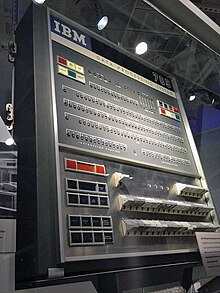
The IBM 709 is a computer system that was initially announced by IBM in January 1957[1] and first installed during August 1958.[2][3][4] The 709 was an improved version of its predecessor, the IBM 704, and was the third of the IBM 700/7000 series of scientific computers. The improvements included overlapped input/output, indirect addressing, and three "convert" instructions which provided support for decimal arithmetic, leading zero suppression, and several other operations. The 709 had 32,768 words of 36-bit magnetic core memory and could execute 42,000 add or subtract instructions per second. It could multiply two 36-bit integers at a rate of 5000 per second.[5]
An optional hardware emulator executed old IBM 704 programs on the IBM 709. This was the first commercially available emulator. Registers and most 704 instructions were emulated in 709 hardware. Complex 704 instructions such as floating-point trap and input-output routines were emulated in 709 software.
The FORTRAN Assembly Program was introduced for the 709.
It was a large system; customer installations used 100 to 250 kW to run them and almost as much again on the cooling. It weighed about 2,110 pounds (960 kg) (without peripheral equipment).[6] The 709 was built using vacuum tubes.
IBM announced a transistorized version of the 709, called the IBM 7090, in 1958, only a year after the announcement of the 709, thus cutting short the 709's product life.
- ^ Fisher, Franklin M.; McKie, James W.; Mancke, Richard B. (October 1983). IBM and the U.S. data processing industry: an economic history. Praeger. p. 37. ISBN 9780030630590.
- ^ Schulz, Peter R. (1970). The Composition of the Computer Market: Past, Present, Future : a Report. Stanford-Sloan Program, Graduate School of Business, Stanford University. p. 8.
- ^ Chapin, Ned (1963). An introduction to automatic computers. Van Nostrand. p. 192.
- ^ "WDPC Negotiations". personal.anderson.ucla.edu. September 16, 1958: The IBM 709 computer arrives (26 tons of iron). Retrieved 2018-01-21.
Use of the big computer, second of its type to come off the assembly line, is being given to the WDPC (...)
{{cite web}}: CS1 maint: others (link) - ^ IBM 709 at Columbia University history page
- ^ IBM 709 Data Processing System BRL report, (details of each installation) with photos